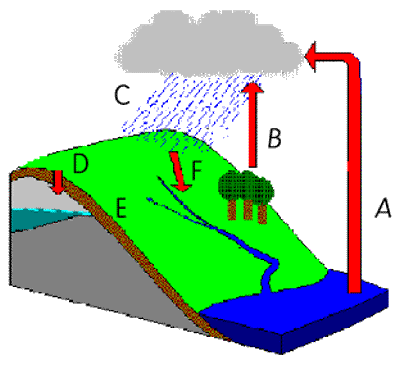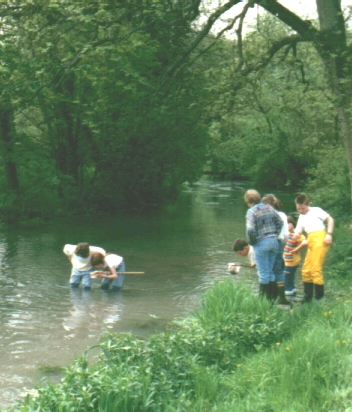Return
THE WATER CYCLE
97% of the Earth's water is held in the oceans, with the
remaining 3% shared between glaciers, icecaps, rivers, lakes, groundwater and
the atmosphere. As water evaporates (A), it rises as water  vapour. When this cools, it condenses
to form clouds. When the water droplets become too large, they fall as precipitation
in the form of snow, hail or rain (C). The water may fall directly back into
the ocean but when it falls on land a more complicated path is followed. The
water may flow into rivers as surface run-off water (F) or pass through plants
where it is transpired back into the atmosphere (B). Some water passes through
the soil and saturates underlying permeable rock (D). This water store is known
as an aquifer, with the upper limit of the water called the water table. Where
this water is prevented from passing further downward by impermeable rock, it
appears at the surface as a spring (E). Here streams may form which flow with
gravity and widen as they collect more water on their route, eventually forming
rivers before flowing back into the sea.
vapour. When this cools, it condenses
to form clouds. When the water droplets become too large, they fall as precipitation
in the form of snow, hail or rain (C). The water may fall directly back into
the ocean but when it falls on land a more complicated path is followed. The
water may flow into rivers as surface run-off water (F) or pass through plants
where it is transpired back into the atmosphere (B). Some water passes through
the soil and saturates underlying permeable rock (D). This water store is known
as an aquifer, with the upper limit of the water called the water table. Where
this water is prevented from passing further downward by impermeable rock, it
appears at the surface as a spring (E). Here streams may form which flow with
gravity and widen as they collect more water on their route, eventually forming
rivers before flowing back into the sea.
A - Evaporation B - Transpiration C - Precipitation
D - Percolation E - Spring-line F - Surface run-off
WATER AND MAN
 Water is a vital resource
required in homes and industry and is considered part of the daily routine.
Europe is fortunate in having adequate rainfall to cope with its water requirements.
In Britain 99% of homes are connected to a public water supply and with water
readily available average consumption is 147 litres per person per day.
Water is a vital resource
required in homes and industry and is considered part of the daily routine.
Europe is fortunate in having adequate rainfall to cope with its water requirements.
In Britain 99% of homes are connected to a public water supply and with water
readily available average consumption is 147 litres per person per day.
Over the last 30 years there has been an increase in water demand of over
10% and this is expected to double in the next 20 years. This will largely
be due to an increasing population as well as an increase in personal water
use. It is predicted that climate change will also add to water demand with
a 1% increase in temperature leading to a 4% increase in water consumption
through personal use.
The largest demand for water outside of homes is for electricity generation,
fish farming and industry. Other uses such as irrigation and ornamental
use are expected to become more significant in the future.
Water can be used to produce electricity through hydroelectric power (HEP).
Presently around 25% of the world's electricity is produced from HEP. One
method of HEP generation is the use of falling water to turn turbines that
power generators. Hydro-electric power stations often use dams or reservoirs
as water stores to ensure a constant supply of water, one example is on
the River Rhine in Germany. In the future this may not be possible; with
a drier climate increased evaporation and less precipitation will lower
the potential for HEP.
Return
 vapour. When this cools, it condenses
to form clouds. When the water droplets become too large, they fall as precipitation
in the form of snow, hail or rain (C). The water may fall directly back into
the ocean but when it falls on land a more complicated path is followed. The
water may flow into rivers as surface run-off water (F) or pass through plants
where it is transpired back into the atmosphere (B). Some water passes through
the soil and saturates underlying permeable rock (D). This water store is known
as an aquifer, with the upper limit of the water called the water table. Where
this water is prevented from passing further downward by impermeable rock, it
appears at the surface as a spring (E). Here streams may form which flow with
gravity and widen as they collect more water on their route, eventually forming
rivers before flowing back into the sea.
vapour. When this cools, it condenses
to form clouds. When the water droplets become too large, they fall as precipitation
in the form of snow, hail or rain (C). The water may fall directly back into
the ocean but when it falls on land a more complicated path is followed. The
water may flow into rivers as surface run-off water (F) or pass through plants
where it is transpired back into the atmosphere (B). Some water passes through
the soil and saturates underlying permeable rock (D). This water store is known
as an aquifer, with the upper limit of the water called the water table. Where
this water is prevented from passing further downward by impermeable rock, it
appears at the surface as a spring (E). Here streams may form which flow with
gravity and widen as they collect more water on their route, eventually forming
rivers before flowing back into the sea. Water is a vital resource
required in homes and industry and is considered part of the daily routine.
Europe is fortunate in having adequate rainfall to cope with its water requirements.
In Britain 99% of homes are connected to a public water supply and with water
readily available average consumption is 147 litres per person per day.
Water is a vital resource
required in homes and industry and is considered part of the daily routine.
Europe is fortunate in having adequate rainfall to cope with its water requirements.
In Britain 99% of homes are connected to a public water supply and with water
readily available average consumption is 147 litres per person per day.